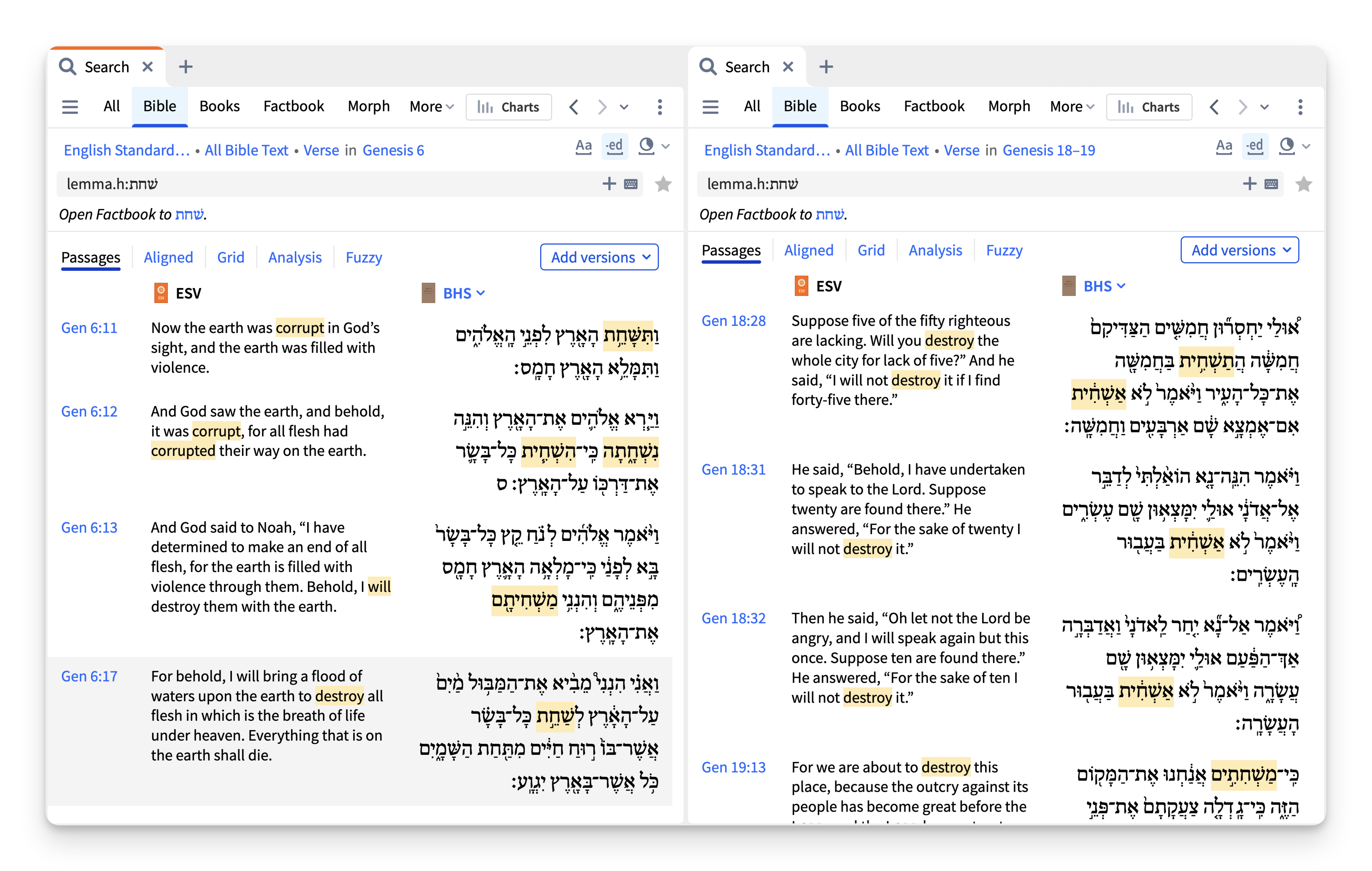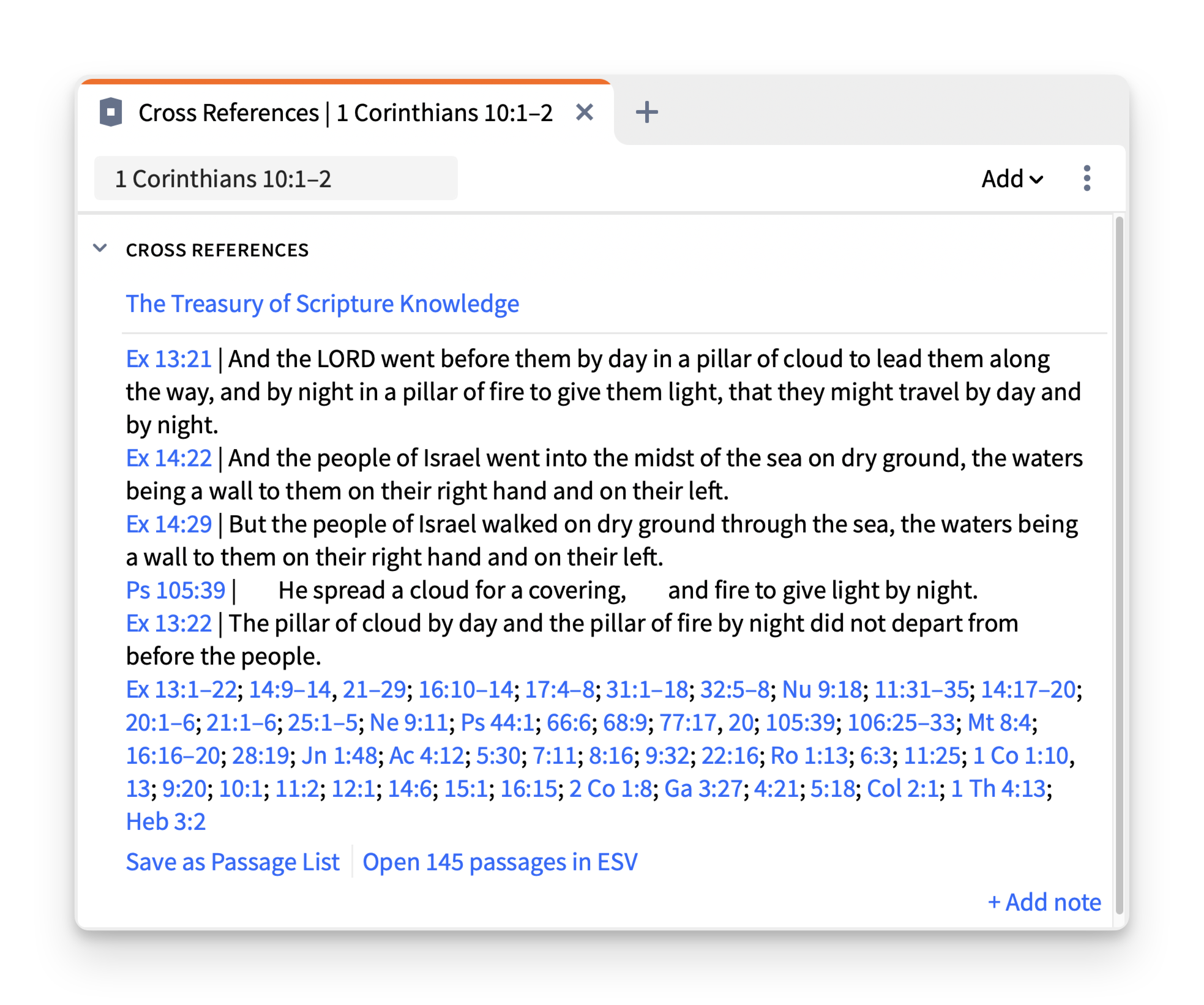I offer a controversial claim: Baptizing babies by sprinkling or pouring does not comport with the typological function of the floodwaters of God’s judgment in the Old Testament. Rather, I contend that, by understanding typology and this particular instance of it, we will see that baptism is the immersion of a believer in water.
To prove my case, we will first ask, what is typology and how does it work? I will offer a definition of typology and show how the biblical authors establish it in their writings. From there I will illustrate these principles with an example of typology that begins with the flood and ends with baptism.
We will conclude that Peter (1 Pet 3:20–21) understands baptism as an immersion in water. That is to say, Peter would not accept a pouring or sprinkling of water as constituting a baptism. Baptism requires immersion in water.
How the biblical authors establish typological patterns
I define typology as God-ordained, author-intended historical correspondence and escalation in significance between people, events, and institutions across the Bible’s redemptive-historical story.1 Under the inspiration of the Holy Spirit, the biblical authors saw patterns in what God orchestrated in history, and they intended to draw the attention of their audience to those patterns because the “typical” way that God acted in the past indicates the type of thing he will do in the future.
Typology is God-ordained, author-intended historical correspondence and escalation in significance between people, events, and institutions across the Bible’s redemptive-historical story.
How do the biblical authors establish the historical correspondences between people, events, and institutions in the covenantal context of the Bible’s story? They do this by re-using key terms and phrases, quoting whole lines, and presenting repeated sequences of events. When these features join with a similarity of sequence or import, we can be reasonably sure that the biblical author intends to create historical correspondence. When we see a biblical author present repeated instances of a pattern, we naturally suspect that what an author repeats or emphasizes grows in significance. This is what is referred to as “escalation in significance.”2
Tracing the Bible’s floodwater typology
The flood provides us with a good example of this phenomenon. Within his own writings, Moses repeatedly presents the “type” of thing that God does when he judges his enemies and saves his people. The pattern that Moses establishes, a pattern of the “baptism” of God’s enemies in the floodwaters of his wrath, is then discerned by prophets and psalmists, who present the pattern in their writings as the “type” of thing that God does for his people, “typifying” the way he will save them in the future. The Lord Jesus presents his own death on the cross in terms of this pattern, and his apostles teach followers of Jesus to understand baptism in these terms.
The flood (Gen 6–9)
The flood in Genesis 6–9 is the initial installment in the pattern of events we are considering here. In what follows we will see that Moses refers back to the flood to establish connections between that act of judgment and others that follow in Genesis and Exodus.
I do want to observe at this point, however, that when God commands Noah to build the ark because of the coming flood, Noah responds to God’s instructions by faith. The ark, moreover, was a massive project that likely required the investment of all of Noah’s time and resources. He was saved through the floodwaters of God’s wrath because he believed. His belief was the kind that resulted in action. Noah believed God and built the boat.
Sodom (Gen 18–19)
When Moses narrates the destruction of Sodom in Genesis 19, he intends to remind his audience of the destruction of the world at the flood. This is but a sampling of the evidence for that conclusion:
- The term that Moses presents the Lord using when he says he will “destroy” the earth with a flood in Genesis 6:13 and 17, which he says he will never do again in 9:11 and 15, is the same term he uses to speak of the destruction of Sodom twice in 18:28, again in 18:31–32, twice in 19:13, and in 19:14 and 29.
- The term used to describe the shutting of the ark in Genesis 7:16 is also used to describe the shutting of Lot’s door in 19:6 and 19:10.
- Noah found favor in the Lord’s eyes in Genesis 6:8, and Lot recognizes that he has found favor in the eyes of the angels from the Lord in 19:19.
- The Lord worked to “keep alive” Noah and the animals in 6:19–20, and Lot recognizes that he is being “kept alive” in 19:19.
- The term used to describe the Lord sending the rain of the flood in 7:4 is the same used to describe the Lord “raining down” brimstone and fire in 19:24.

Use Logos to search instances of the Hebrew word for “destroy” in Genesis. Don’t have Logos? Get started free.
More could be said, but this is enough for this brief presentation. At the flood and at Sodom, Noah and Lot and those with them were saved from the Lord’s judgment. In both cases, the Lord first reveals himself, the revelation is believed, he then saves his people, and destroys the wicked, and then in both cases the salvation is followed by a failure on the part of Noah and Lot involving drunkenness, shameful nakedness, and sinful actions by their children. The pattern of events at the flood is repeated at the destruction of Sodom.
The Red Sea (Exod 14–15)
The use of key terms and phrases in the description of the deliverance of Israel and the destruction of Egypt at the Red Sea indicates that Moses wants to forge a connection between the flood and the Red Sea crossing. Consider the following evidence:
- The only previous instance of the term used for “dry land” in Exodus 14:21 is in Genesis 7:22.
- The phrase used to describe “the waters returning” in Exodus 14:28 is the same used in Genesis 8:3.
- The term that describes how the waters “covered” the Egyptians in Exodus 14:28, 15:5, and 15:10 was used to speak of how the waters “covered” the mountains in Genesis 7:19–20.
More could be said about points of contact between the flood and the crossing of the Red Sea, but this is enough to set up the similarity in event-sequence and in covenantal import. Noah is a kind of new Adam (compare Gen 1:28; 9:1, 7), and he is saved through the watery destruction of the enemies of God. Israel likewise is God’s firstborn son (Exod 4:22–23), and the nation is saved through the watery destruction of Pharaoh and his hosts.
Assyrian invasion (Isa 8)
By repeating the pattern of a watery judgment that deluges his enemies, Moses established the flood as the type of thing that God does when he brings justice against the wicked. He initiated the pattern in the flood in which Noah was saved. Moses then portrayed the destruction of Sodom in similar terms, reiterating the same in the destruction of Egypt at the Red Sea.
Isaiah understood the pattern, as can be seen when in Isaiah 8:5–8 he threatens Israel that God is about to bring judgment against them. In this passage, Isaiah symbolically describes the King of Assyria and his army, which the Lord will use to visit the curses of the covenant on Israel (Deut 27:15–68), as an overflowing flood of waters that will “overflow and pass over even to the neck” (Isa 8:8, my translation). The threatened judgment is such that Israel will barely keep their heads above the water, everything else being submerged. Isaiah later narrates the invasion of the king of Assyria, and the king surrounds Jerusalem like floodwaters that rise to a man’s neck (cf. Isa 36–39).
Raging waters (Ps 124)
In Psalm 124, David generalizes the flood imagery to speak of Israel’s experience with her enemies. In verse 2, he makes clear that he is speaking of “people” rising up against Israel, but then in verses 4–5 he speaks of them like a “flood” that would have “swept us away,” a “torrent” that “would have gone over us.” This torrent is then spoken of as “raging waters” (ESV).
Here again, the idea is that God would be visiting judgment against Israel by means of a human army. That human army is likened to a flood to connect it to God’s wrath visited in Noah’s flood.
Jesus’s crucifixion (Mark 10)
This Old Testament background explains why Jesus would speak of his death on the cross as a “baptism.”
The world was baptized in the floodwaters of God’s wrath at Noah’s flood. God’s wrath then fell on Sodom, and that event was presented in terms reminiscent of the flood (Jesus links the flood and Sodom in Luke 17:26–29). Then the Egyptians were submerged in the waters of God’s wrath when the Red Sea closed over them. When the nation of Israel broke the covenant and faced God’s judgment, that judgment was described in terms of floodwaters in places like Isaiah 8 and Psalm 124.
Christ’s death on the cross was a baptism in the floodwaters of God’s wrath.
Jesus thus spoke of his death symbolically as a baptism to connect it with the floodwaters of God’s wrath. As Jesus dies in place of his people, becoming a curse for them (Gal 3:13), he told his followers he had a cup to drink (the cup of the wine of God’s wrath), a baptism to undergo (Mark 10:39). Immediately afterward he spoke of giving his life as a ransom for many (10:45). Christ’s death on the cross was a baptism in the floodwaters of God’s wrath.
Baptism into Moses (1 Cor 10)
Following the cues that Moses built into his narrative in Exodus 14–15, Paul links the Red Sea crossing to Christian baptism in 1 Corinthians 10:1–2. Paul writes,
our fathers were all under the cloud, and all passed through the sea, and all were baptized into Moses in the cloud and in the sea. (ESV)
Here he makes a typological connection between the experience of Israel at the exodus and the experience of Christians at their conversion. The point of connection that links these two is the baptism of Christ on the cross.
Israel was saved through the waters of judgment when they passed through the sea that closed on Egypt. Christians are saved through the waters of judgment in which Jesus was submerged (see Mark 10:39). Thus, Israel was baptized in the same way that Christians were: Israel passed through the waters of death to life on the other side. Those waters of death closed on their enemies. Similarly, Christians pass through the waters of death when they are immersed in the waters of baptism, waters in which Christ, symbolically speaking, died.3

Try Logos’s Cross Reference tool in 1 Corinthians 10:1–2 to explore its connections across the canon. Don’t have Logos? Get started free.
Christian baptism (1 Pet 3)
Similar concepts are at work when Peter connects the flood with baptism in 1 Peter 3:20–21. He writes,
in the days of Noah, while the ark was being prepared, in which a few, that is, eight persons, were brought safely through water. Baptism, which corresponds to this, now saves you. (ESV)
I contend that the typological connection Peter makes between the flood and Christian baptism goes like this: Noah believed God, and by faith he built the ark. Christians believe the gospel, and by faith they live for Christ. In the ark, Noah was saved through the “baptism” (floodwaters) of God’s wrath in which God’s enemies died. In Christ, believers are saved through their baptism into Christ’s death, wherein he died, bearing “our sins in his body on the tree” (1 Pet 2:24 ESV), “the chastisement that brought us peace” being on him (Isa 53:5 ESV), so that we have been healed by his wounds (1 Pet 2:24; Isa 53:5).
When Christ died on the cross, he was submerged in the floodwaters of God’s wrath, just as the wicked were in the days of Noah. Because Noah believed and built the ark, he was saved through that baptism. Similarly, Christians put their faith in Christ, and his experience of the floodwaters of God’s wrath counts for them. When we trust in Christ, we are united to him by faith, so that we can be buried with him in baptism, raised to walk in newness of life (Rom 6:3–4). This is precisely what baptism depicts, the believers’ participation in Christ’s death and resurrection.
God judged his enemies with the floodwaters of his wrath at Noah’s flood, at the Red Sea, and at the cross. In each case, his people are brought through the floodwaters of wrath alive. Thus does Christian baptism fulfill what is typified at the flood and at the Red Sea.
The world’s fiery end (2 Pet 3)
In 2 Peter 3:5–7, Peter writes,
the earth was formed out of water and through water by the word of God, and that by means of these the world that then existed was deluged with water and perished. But by the same word the heavens and earth that now exist are stored up for fire, being kept until the day of judgment and destruction of the ungodly. (ESV)
Here Peter connects the baptism of the world at the flood with the baptism of the world in fire at the end of all things. This could explain John the Baptist’s saying that he baptizes with water, but after him comes one who baptizes with the Holy Spirit and fire (Matt 3:11). John could be pointing to the fiery judgment Jesus brings at his return (2 Thess 1:7–8).
Above we already referenced the connection Jesus made between the flood and Sodom (Luke 17:26–29). Interestingly, in that context, he speaks of the return of the Son of Man (Luke 17:24–25, 30–37).
Conclusion: baptism as an immersive flood
The world was immersed in water (baptized) at the flood of Noah. God visited fiery judgment on Sodom, and Moses speaks of that event in a way that recalls the flood. Then the Egyptians were immersed in the waters of the Red Sea. Isaiah and David spoke of human enemies who would execute God’s covenant wrath in terms of floodwaters. Jesus spoke of his death under the wrath of God as a baptism he had to undergo. Because he died and was buried, we can say that Jesus was immersed in those waters.
Thus, because of the symbolism at work in baptism, I do not think that the biblical authors were thinking of baptism as a pouring or sprinkling of water over a person. Just as the waters of the flood covered the world, just as the waters of the Red Sea covered the Egyptians, just as the waters of death closed over Jesus, so believers in Jesus go under the water when they are baptized.
Believers in Jesus are united with Christ in his death and resurrection. So it is natural that they would be baptized into his death and resurrection (Matt 28:18–20; Rom 6:3–4). The immersion of a believer in water explains why Paul would say that we have been “buried therefore with him by baptism into death” (Rom 6:4). Immersion depicts this burial.
I have made the case here that Paul’s words about the Red Sea (1 Cor 10:1–2) and Peter’s words about the flood (1 Pet 3:20–21) are in keeping with the way that Jesus interpreted the Old Testament (Mark 10:39), which is the way that Moses intended the flood and the Red Sea to be understood. Moses presented these as connected events involving floodwaters of God’s wrath destroying God’s enemies through which God’s people were delivered. Jesus brought this to fulfillment when he died under God’s wrath at his baptism on the cross. Believers in Jesus are immersed in water in typological fulfillment of the salvation of Noah at the flood (1 Pet 3:20–21) and of Israel at the Red Sea (1 Cor 10:1–2).
Continue your study with more books by James M. Hamilton
Typology: Understanding the Bible’s Promise-Shaped Patterns; How Old Testament Expectations are Fulfilled in Christ
Regular price: $39.99
What Is Biblical Theology? A Guide to the Bible’s Story, Symbolism, and Patterns
Regular price: $8.99
With the Clouds of Heaven: The Book of Daniel in Biblical Theology (New Studies in Biblical Theology, vol. 32 | NSBT)
Regular price: $19.99
Song of Songs: A Biblical-Theological, Allegorical, Christological Interpretation (Focus on the Bible | FB)
Regular price: $10.99
Work and Our Labor in the Lord (Short Studies in Biblical Theology)
Regular price: $9.99
God’s Indwelling Presence: The Holy Spirit in the Old and New Testaments (NAC Studies in Bible and Theology | NACSBT)
Regular price: $7.99
Exalting Jesus in Ezra-Nehemiah (Christ-Centered Exposition Commentary | CCE)
Regular price: $11.99
Related articles
- Baptism of the Holy Spirit: What It Means & How We Get It Wrong
- What’s Typology? Patterns of Creation in Redemptive History
- Seeing Christ in Job: An Exercise in Typological Reading
- The Meaning of Baptism—and How It Makes the Gospel Visible
- James M. Hamilton Jr., Typology—Understanding the Bible’s Promise-Shaped Patterns: How Old Testament Expectations Are Fulfilled in Christ (Grand Rapids, MI: Zondervan, 2022), 26.
- See further Hamilton, Typology, 1–28.
- I say “symbolically speaking” because Jesus was not drowned but crucified.





